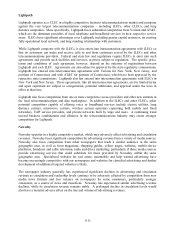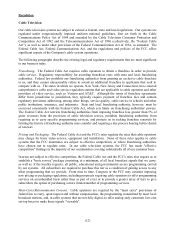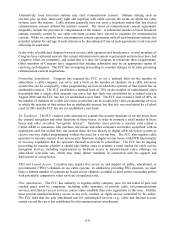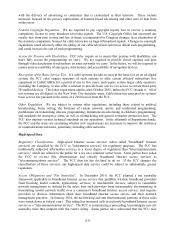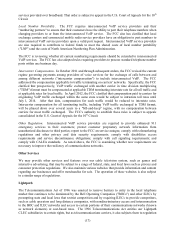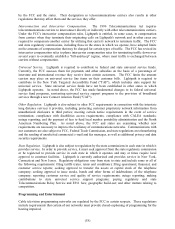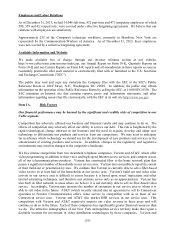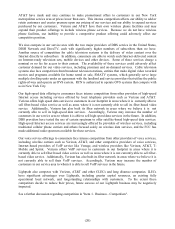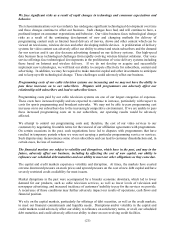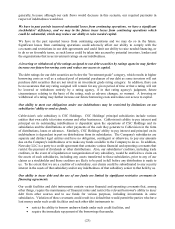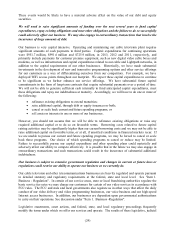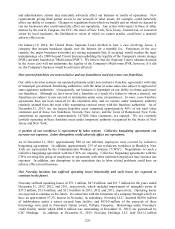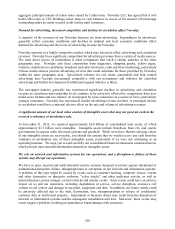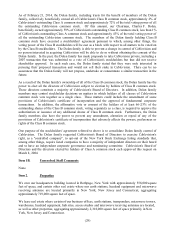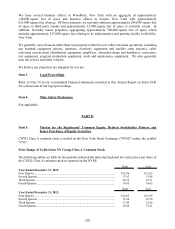Cablevision 2013 Annual Report Download - page 26
Download and view the complete annual report
Please find page 26 of the 2013 Cablevision annual report below. You can navigate through the pages in the report by either clicking on the pages listed below, or by using the keyword search tool below to find specific information within the annual report.
(20)
AT&T have made and may continue to make promotional offers to customers in our New York
metropolitan service area at prices lower than ours. This intense competition affects our ability to add or
retain customers and creates pressure upon our pricing of our services and our ability to expand services
purchased by our customers. Verizon and AT&T have their own wireless phone facilities and may
expand their product offerings to include wireless phone services. Because we do not have wireless
phone facilities, our inability to provide a competitive product offering could adversely affect our
competitive position.
We also compete in our service area with the two major providers of DBS service in the United States,
DISH Network and DirecTV, each with significantly higher numbers of subscribers than we have.
Another source of competition for cable television systems is the delivery of video content over the
Internet directly to subscribers. In addition, consumers are able to watch such Internet-delivered content
on Internet-ready television sets, mobile devices and other devices. Some of these services charge a
nominal or no fee for access to their content. The availability of these services could adversely affect
customer demand for our video services, including premium and on-demand services. Cable television
systems also face competition from broadcast television stations, entities that make digital video recorded
movies and programs available for home rental or sale, SMATV systems, which generally serve large
multiple dwelling units under an agreement with the landlord and service providers that utilize the public
rights-of-way and operate an OVS system. RCN is authorized to operate OVS systems that compete with
us in New York City.
Our high-speed data offering to consumers faces intense competition from other providers of high-speed
Internet access including services offered by local telephone providers such as Verizon and AT&T.
Verizon offers high speed data services to customers in our footprint in areas where it is currently able to
sell fiber-based video service as well as areas where it is not currently able to sell its fiber-based video
service. Additionally, Verizon has also built its fiber network in areas where we believe it is not
currently able to sell its high-speed data services. Accordingly, Verizon may increase the number of
customers in our service area to whom it is able to sell high-speed data services in the future. In addition,
DBS providers have tested the use of certain spectrum to offer satellite-based high-speed data services.
High-speed Internet access services are increasingly offered by providers of wireless services, including
traditional cellular phone carriers and others focused solely on wireless data services, and the FCC has
made additional radio spectrum available for these services.
Our voice service offerings to consumers face intense competition from other providers of voice services,
including wireline carriers such as Verizon, AT&T, and other competitive providers of voice services,
Internet-based providers of VoIP service like Vonage, and wireless providers like Verizon, AT&T, T-
Mobile and Sprint. Verizon offers VoIP services to customers in our footprint in areas where it is
currently able to sell fiber-based video service as well as areas where it is not currently able to sell fiber-
based video service. Additionally, Verizon has also built its fiber network in areas where we believe it is
not currently able to sell their VoIP services. Accordingly, Verizon may increase the number of
customers in our service area to whom it is able to sell VoIP services in the future.
Lightpath also competes with Verizon, AT&T and other CLECs and long distance companies. ILECs
have significant advantages over Lightpath, including greater capital resources, an existing fully
operational local network, and long-standing relationships with customers. To the extent these
competitors decide to reduce their prices, future success of our Lightpath business may be negatively
impacted.
See a further discussion regarding competition in "Item 1. Business - Competition".



